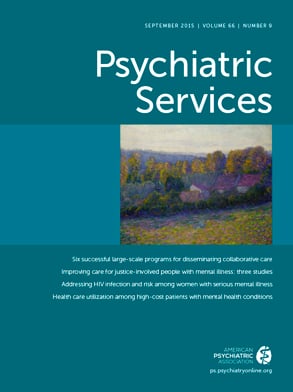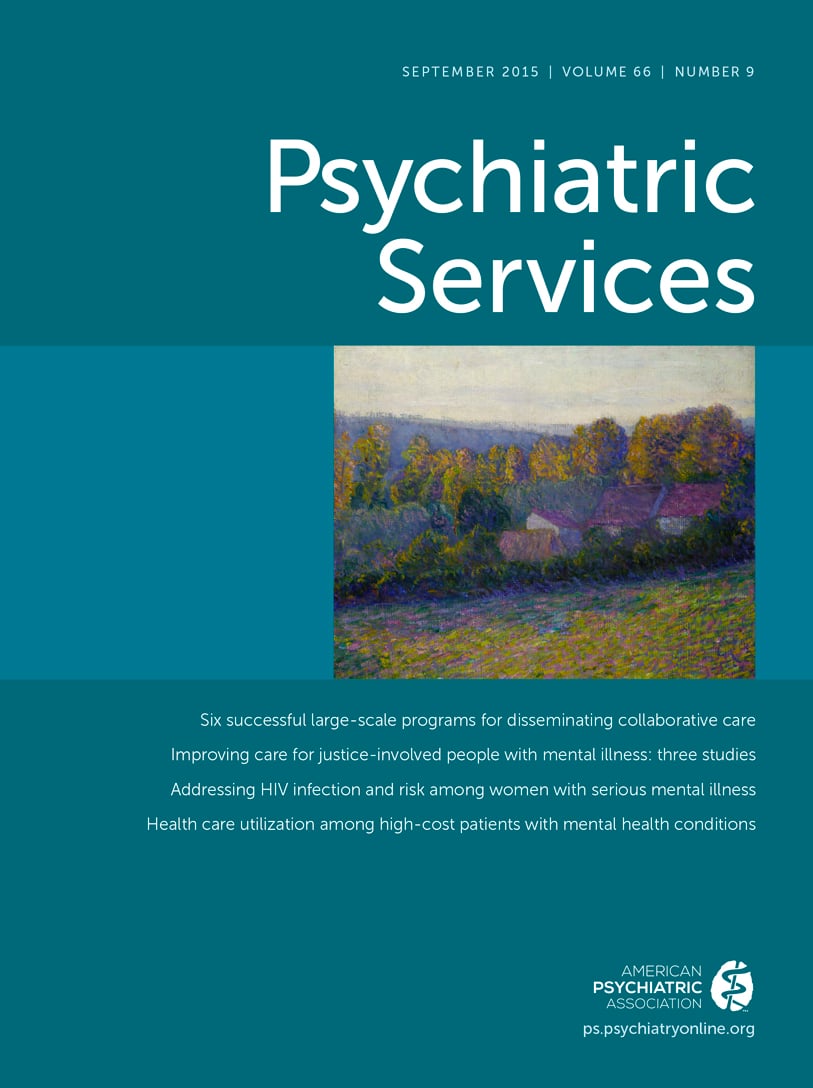Mental disorders among military service members are a significant public health concern. Several studies have found that National Guard (NG) service members exhibit higher rates of posttraumatic stress disorder (PTSD), depression, and interpersonal difficulties than active component service members (
1). Despite these findings, rates of mental health service use in several NG organizations have remained low (
2,
3). A greater understanding of factors associated with mental health service use will help improve care for these individuals.
Mental health service use can include a variety of services, including use of prescribed psychotropic medications and individual or group psychotherapy, and services can be provided in a variety of settings, ranging from primary care to specialty mental health clinics. Low socioeconomic status (SES) may be associated with use of various mental health services in various settings. Several studies have reported that low education (
4,
5) and low income (
4,
6) are associated with reduced use of mental health services, which may be attributable to the cost of private-sector care or different perceptions of need among persons with less education. However, low income has been found to be associated with greater use of mental health services in some samples (
3,
7,
8), and some studies have reported no association between income (
9) or education (
9,
10) and use of mental health services. Thus the relationship between SES and use of mental health services is difficult to disentangle.
The aim of this study was to assess the relationship between SES and mental health service use among NG soldiers. Discrepancies in the literature regarding the link between SES and mental health service use may result from differences in the specific types of mental health services examined. To address issues with variation in the types of services assessed, we examined both overall use of mental health services and use of specific types of services (psychotropic medication, individual therapy, group therapy, substance abuse treatment, and family and marital therapy). Although previous findings regarding the link between SES and service utilization are discrepant, we hypothesized, on the basis of a slightly greater preponderance of evidence, that lower SES would be associated with reduced use of mental health services.
Methods
Survey participants were recruited from NG soldiers in a Midwestern state, approximately six months after their return home from deployments to either Iraq or Afghanistan, as part of a larger study to examine the outcomes of NG veterans over time and implementation of a peer outreach program. Soldiers were recruited in person during monthly drill weekends and by mail (
11). Data collection extended from August 2011 through August 2012. Institutional review board approval was obtained through the Department of Veterans Affairs (VA) Ann Arbor Healthcare System. Data were collected under an approved waiver of written informed consent. Further details about the study have been published elsewhere (
11).
Past-year use of mental health services was assessed by 14 items, which asked participants whether they “had received mental health services for a stress, emotional, alcohol, or family problem” from either general medical or mental health providers in several different settings, including military, civilian, VA health clinics, or Vet Centers (
11). Another item asked participants to indicate which types of services they received in the past 12 months.
Multivariable logistic regression was used to calculate adjusted odds ratios (ORs) with 95% confidence intervals (CIs) for the use of mental health services. Independent variables were entered into the model in four sequential blocks, loosely based on the Andersen model (
12). Block 1 (predisposing characteristics) included demographic variables, combat exposure, and composite SES, calculated as the sum of Z scores of education and income. In block 2 (factors associated with mental health service use), we added the physical component score from the 12-item Short-Form Health Survey (SF-12) and hazardous alcohol use (as indicated by a positive screen with the Alcohol Use Disorders Identification Test). Block 3 (need factors) included all of the above variables plus indicators of probable psychiatric diagnosis (PTSD, generalized anxiety disorder, and depression). Block 4 additionally tested the interaction between SES and each probable psychiatric diagnosis. Models testing the association with use of specific types of services included all covariates and added private health insurance status. Exploratory analyses tested the relationship between each proxy SES variable (education, income, and rank) and service use. [Further details about the study methods are included in an online
supplement to this report.]
Results
The final sample consisted of 1,268 soldiers—1,179 men (93%) and 89 women (7%). Forty-nine percent (N=626) of the sample was over 30. A total of 1,065 soldiers (84%) were white. The time between return from deployment and survey completion ranged from 125 to 143 days (mean=190±23). Mental health services were used by 401 soldiers (32%) in the full sample. A total of 321 soldiers (25%) had mental health conditions, and 188 (59%) of these soldiers had used mental health services. VA services were used by 120 (38%) of those with mental health conditions and by 94 (49%) of the 193 soldiers with probable PTSD. Among those with probable PTSD, community care was used by 70 soldiers (36%).
Table 1 presents results from the logistic regression models estimating the association between composite SES and mental health service use, with all other variables entered as covariates in four blocks. Six individuals did not have complete data and thus could not be included in multivariable models, leaving a final sample of 1,262. SES was not significantly associated with overall likelihood of mental health service use in any of the four models. However, a number of other significant covariates emerged and remained significant in the fully adjusted model. Male gender and higher SF-12 physical component score (indicating better physical health) were associated with a lower likelihood of service use. Older soldiers, those who had experienced combat, and those with a probable PTSD or depression diagnosis were more likely to use services. In a fourth model (results not shown), which tested the interactions between SES and psychiatric diagnosis, none of the interactions were significant. None of the proxy SES variables were significantly associated with likelihood of overall service use. Private health insurance status was also not associated with overall service use.
When specific types of care were examined in fully adjusted logistic regression models, individuals with a higher composite SES had lower odds of using medication than those with a lower composite SES (OR=.83, CI=.72–.96). In addition, a significant interaction was found in the individual therapy model, such that there was a stronger positive relationship between SES and likelihood of use of individual therapy among individuals with PTSD (OR=5.04, CI=2.81–8.90) compared with those without PTSD (OR=1.13, CI=.99–1.30). [Tables in the online supplement present the results of these and other analyses.]
Discussion
We examined the relationship between SES and use of mental health services in a sample of 1,268 NG soldiers and found that SES was not related to overall service use. However, SES was associated with use of specific types of services, such that individuals with higher SES were less likely to use medication and individuals with PTSD were more likely to use individual therapy if they had higher SES.
In fully adjusted models, we did not find an association between SES and overall service use. Previous findings on the relationship between SES and service use are mixed. Some studies have reported that low SES is associated with reduced use of services (
4–
6), but others supported an inverse relationship (
3,
7,
8) and still others reported a null association (
9). Indeed, there are plausible explanations for a bidirectional effect of SES on treatment. In Andersen’s behavioral model of health service utilization (
12), income is an enabling factor because it enhances access to care. But lower income may also be associated with poorer mental health (
7), thus necessitating higher-intensity treatment. Differences in reported findings may also be partially attributable to different ways of assessing SES. In this study, none of our SES variables—education, income, military rank, or composite SES—were associated with differences in overall use of mental health services. Thus the way that SES is indexed may not affect the strength of the relationship between SES and service use among NG soldiers. This nonsignificant association may, in fact, speak to the outreach efforts provided by VA and to the VA’s emphasis on providing evidence-based treatments. Soldiers returning from the recent conflicts in Iraq and Afghanistan are eligible for five years of free care in VA facilities, which may help reduce the impact of income on mental health service use by soldiers for whom VA care is acceptable or desired. VA services were utilized by over a third of those with a mental health condition and by half of those with PTSD. Thus equitable service provision from the VA is one potential explanation for the lack of association observed between SES and overall mental health service use.
Despite a lack of association between SES and overall service use, significant associations were found between SES and use of specific types of services. In adjusted regression models, individuals with higher SES were less likely to use medication. In addition, a significant interaction was found between SES and PTSD in the model assessing use of individual therapy such that individuals with PTSD who had higher SES were more likely to use individual therapy. Few studies have investigated this topic, but there is some evidence to suggest that the type of treatment used varies by SES. Higher SES may be associated with greater lifetime use of psychotherapy (
13) or greater use of privately provided psychotherapy (
14). Barriers to psychotherapy among NG veterans with lower SES could include time constraints, transportation problems, less flexible work schedules, or poorer health insurance coverage. Use of psychotropic medication may also vary by SES (
15). In our sample, individuals with low SES were more likely to use psychotropic medication. Pharmacotherapy is less time intensive than psychotherapy, and individuals with fewer resources may prefer this option. In addition, patients at various SES levels may have differing views of medication and psychotherapy. Future studies should examine provider and institutional factors that may be associated with discrepant use of psychotherapy versus medication by individuals at various SES levels. Future work should also assess whether SES is differentially associated with use of mental health services in different locations and by individuals with various psychiatric disorders.
The study had several limitations. First, our NG sample might not have included the full range of SES levels found in the larger population. Second, we did not ask about the location of specific services used. Future studies should assess whether individuals use different types of services at various locations (for example, VA programs and community providers). Our study was also limited by the cross-sectional nature of our data. Longitudinal studies are needed to assess the impact of preexisting SES factors on subsequent use of treatment. In addition, mental health service use was based on self-report and thus may have been subject to recall bias. Finally, it is possible that some individuals in the larger sample who were previously symptomatic had achieved remission after treatment, which would have removed them from the subset of individuals experiencing clinical levels of symptoms at the time of data collection.
Conclusions
Overall mental health service use was not related to SES. However, use of specific types of services may be associated with SES. Further research is needed to understand factors contributing to different rates of use of medication and psychotherapy among individuals from different socioeconomic strata.

